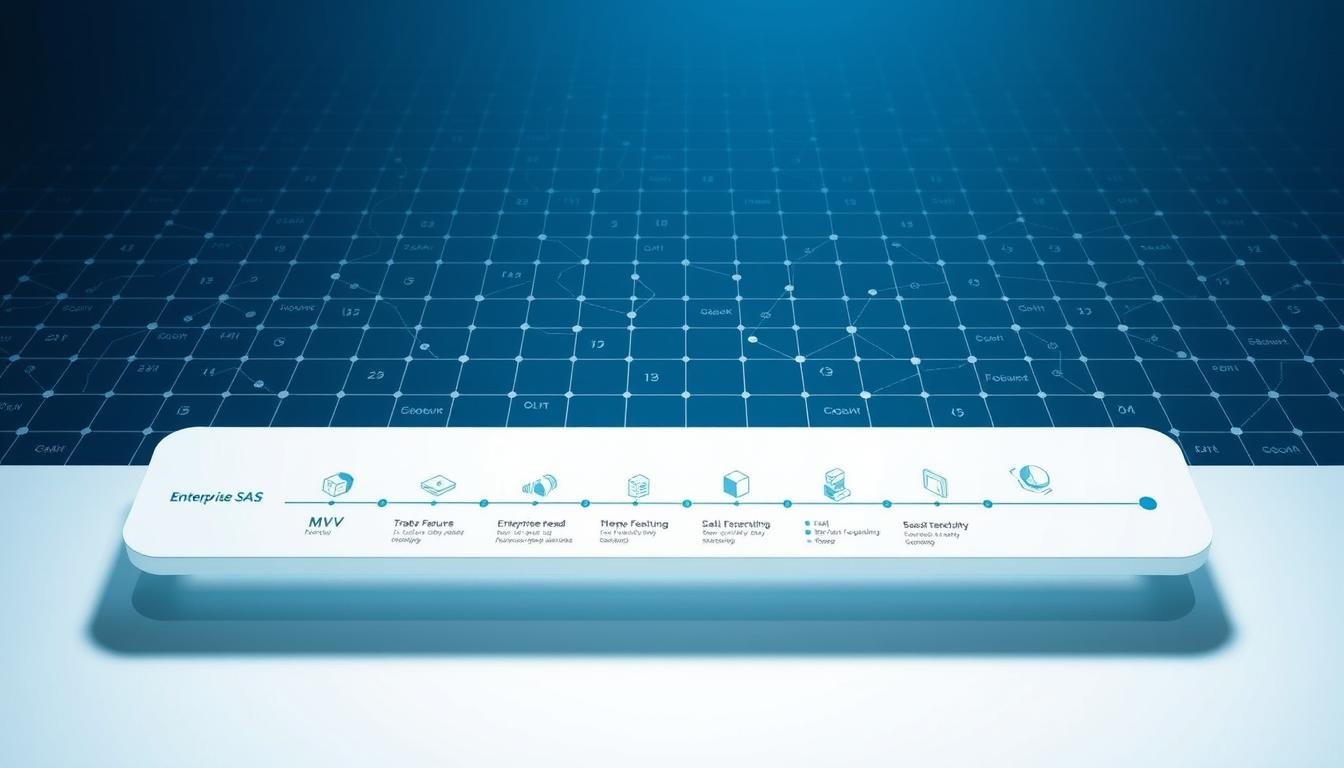What if your MVP’s success is actually holding your software back from enterprise adoption? Many teams discover too late that scaling requires more than just adding features—it demands a complete operational evolution.

Transitioning to serve large organizations means rethinking everything from security protocols to customer onboarding. We’ve seen companies pour resources into compliance certifications, only to realize they lack the customizable workflows enterprise buyers expect. Others struggle with pricing models that work for startups but collapse under complex procurement cycles.
Our experience shows this shift isn’t about chasing revenue—it’s about building infrastructure that scales without stifling innovation. The challenge? Balancing technical debt against market timing while maintaining what made your product unique.
Key Takeaways
- Enterprise readiness requires reworking security, compliance, and support systems
- Large buyers evaluate vendors through formal procurement processes
- Resource planning separates successful scaling attempts from stalled efforts
- Pricing models must align with enterprise budgeting cycles
- Customer success teams need specialized training for complex deployments
Let’s explore how to navigate this transformation without losing your competitive edge. The gap between “good enough” and “enterprise-grade” is wider than most teams anticipate—but crossing it unlocks markets 10X larger than your current reach. Are you prepared to bridge that gap?
The Business Case for a Scalable SaaS Product
What separates thriving software solutions from those stuck in perpetual startup mode? The answer lies in strategic market positioning. Companies that shift focus to enterprise clients unlock revenue streams that dwarf traditional SMB markets while building long-term stability.

Why Moving Upmarket Matters
Enterprise clients don’t just spend more—they invest differently. Our research reveals contracts with large organizations average 4.7X higher annual value than small business deals. “Enterprise buyers prioritize partners who demonstrate scalability first, features second,” notes a Gartner analyst report.
This transition impacts every business function:
- Sales cycles lengthen but close rates improve
- Implementation timelines require precision planning
- Support teams need deeper technical expertise
Impact on Revenue and Customer Lifetime Value
While initial enterprise deals demand more resources, the payoff reshapes financial trajectories. One client achieved 92% lower churn with enterprise accounts versus SMBs over three years. Expansion opportunities compound too—successful deployments often lead to cross-selling across business units.
Consider these financial advantages:
- 5-year customer retention rates 3X higher
- Upsell potential increases by 40-60%
- Referral pipelines grow through case studies
“Enterprise contracts transformed our revenue model from transactional to strategic. Now 68% of our ARR comes from multi-year agreements.”
Timing and Strategic Decision-Making for Enterprise Readiness
Scaling to enterprise-level demands isn’t about luck—it’s about deliberate timing. Companies that align their readiness initiatives with market signals see 73% faster adoption rates than reactive peers. The critical choice: wait for demand to emerge or build capabilities ahead of opportunities.

Pull vs. Push Strategies
Organic pull occurs when mid-market users grow into enterprise roles, creating natural expansion paths. One collaboration platform saw 40% of its SMB clients evolve into enterprise accounts within 18 months. Conversely, strategic push involves targeting Fortune 1000 companies before they know they need you.
Key differences:
- Pull strategies leverage existing user relationships
- Push requires upfront investment in enterprise features
- Timing gaps between approaches impact revenue cycles
Establishing a “Day 1” Enterprise Mindset
Top-performing teams bake scalability into their DNA from initial development. A fintech startup credits its early focus on audit trails and role-based access controls for landing 8-figure banking contracts. “Building enterprise-ready foundations early saved us 18 months of rework,” their CTO notes.
Three signs you’re ready:
- Feature requests shift from functionality to compliance
- Sales teams consistently hear “We love it, but…”
- Support tickets reveal scaling pain points
“Enterprises don’t buy products—they invest in partners. Prove your maturity before they ask.”
Understanding Enterprise Customers and Their Unique Personas
Enterprise sales resemble chess more than checkers—every move must account for multiple decision-makers with competing priorities. Unlike transactional deals, large organizations evaluate vendors through layered filters of risk, value, and strategic alignment.
Security, Compliance, and Procurement Stakeholders
Technical teams demand ironclad proof of data protection. Recent audits show 83% of security leaders reject vendors lacking granular access controls or audit trails. Compliance officers scrutinize certifications like SOC 2 and GDPR adherence, while procurement specialists dissect contract terms for liability clauses.
Common requirements include:
- Real-time activity monitoring dashboards
- Documented encryption protocols for data at rest
- Flexible licensing models matching budget cycles
Aligning Product Features with Decision-Makers’ Needs
End-users might prioritize workflow efficiency, but CISO teams care about breach prevention. One healthcare client secured enterprise contracts by demonstrating automated HIPAA compliance checks during user onboarding. Senior executives seek vendors who can scale with their three-year roadmaps.
Successful alignment requires:
- Custom demo scenarios for different stakeholders
- Clear documentation of disaster recovery plans
- Evidence of ongoing R&D investment
“We don’t buy tools—we adopt partners. Show me how you’ll evolve with our security needs over five years,” explains a Fortune 500 CISO.
Mapping these personas early prevents wasted cycles. Teams that address both functional and governance needs shorten sales cycles by 37% on average.
Essential Security and Compliance Features
Enterprise buyers scrutinize security infrastructure like detectives examining crime scenes. Missing one clue can disqualify vendors instantly. Building trust requires more than checkboxes—it demands proactive proof of ironclad protection.
Implementing SOC 2, ISO 27001, and Other Standards
Certifications act as universal translators for security credibility. SOC 2 Type 1 serves North American markets with snapshot validation, while Type 2 proves operational excellence over 6-12 months. European organizations prioritize ISO 27001’s risk-based approach to data management.
Key implementation insights:
- 80% of SOC 2 preparation involves policy documentation
- ISO 27001 requires annual surveillance audits
- Combining standards strengthens global market access
Advanced Authentication: MFA and SSO Integration
Modern authentication balances fortress-like security with employee convenience. Our teams implement adaptive MFA that analyzes login attempts using:
- Biometric verification for high-risk actions
- Time-based codes for routine access
- SSO integration with Azure AD/Okta
One healthcare client reduced credential-related support tickets by 74% after deploying SAML-based SSO. “Employees stopped writing passwords on sticky notes,” their CISO noted. True security wins when users adopt it willingly.
“We reject 3/4 vendors during procurement reviews—usually for incomplete access controls or audit trails.”
These features form non-negotiable foundations. Organizations that implement them early avoid costly redesigns when enterprise deals materialize.
Streamlining User Management and SCIM Provisioning
Managing user access at scale often becomes the silent killer of enterprise software adoption. Manual processes collapse when dealing with thousands of employees across multiple departments. This is where SCIM (System for Cross-Domain Identity Management) transforms chaos into controlled efficiency.
Automated Lifecycle Management Essentials
Modern enterprises demand systems that mirror their organizational structure. We implement SCIM protocols to synchronize user roles, permissions, and group memberships across all platforms. Key benefits include:
- Instant access revocation during offboarding
- Role-based permissions updated in real-time
- Reduced IT support tickets by 58% on average
| Process | Manual Effort | SCIM Automation | Time Saved |
|---|---|---|---|
| New User Setup | 45 minutes | Instant | 98% |
| Role Changes | 3+ business days | Real-time sync | 95% |
| Access Removal | High risk of delays | Immediate termination | 100% compliance |
Seamless Provisioning Strategies
Large organizations require granular control over access permissions. Our teams design systems that:
- Integrate with Azure AD, Okta, and Ping Identity
- Handle temporary contractors through time-bound access
- Support complex multi-department hierarchies
“SCIM implementation cut our onboarding time from weeks to minutes. Now we safely manage 25,000+ global users.”
These capabilities prove critical when scaling beyond basic user management. Organizations using SCIM report 73% faster deployment cycles for new enterprise clients.
Building vs. Buying Enterprise-Grade Features
How do leading tech companies avoid drowning in technical debt while scaling their platforms? The answer lies in strategic feature development choices. Deciding whether to build custom solutions or integrate existing tools requires balancing speed, control, and long-term flexibility.
Evaluating In-House Capabilities and Resource Requirements
Building enterprise features demands more than engineering talent—it requires sustained commitment. Ask three critical questions:
- Does this align with our core product value?
- Can our team maintain this for 5+ years?
- Will development delay other roadmap priorities?
One client discovered their authentication system required 3X more resources than projected. Maintenance costs consumed 22% of their engineering capacity within 18 months. Underestimating lifecycle costs remains the most common pitfall.
Mitigating Vendor Lock-In Risks
Third-party solutions often come with hidden constraints. We recommend:
- Demanding API access documentation during vendor evaluations
- Negotiating data portability clauses in contracts
- Maintaining parallel proof-of-concept implementations
“We built exit ramps into every integration. When a vendor doubled prices, we migrated in 11 days without client impact.”
| Factor | Build | Buy |
|---|---|---|
| Control | Full customization | Vendor-dependent |
| Speed | 6-18 months | 2-6 weeks |
| Flexibility | Unlimited | Contract terms |
Integrating Audit Trails, Log Streaming, and Uptime SLAs
Operational transparency separates trusted partners from temporary vendors in enterprise software. Large organizations demand visibility into user activity and system performance that matches their internal security protocols.
Tracking User Actions for Forensic Analysis
Detailed audit trails act as digital fingerprints for every interaction. We design systems that capture:
- Timestamped records of login attempts
- Data access patterns across teams
- Configuration changes with user attribution
One financial client traced a potential breach to a contractor’s expired credentials within 14 minutes using these logs. “Without granular audit data, we’d still be guessing,” their security lead noted.
Maintaining High Service Reliability Standards
Uptime SLAs become contractual bedrock for enterprise relationships. Our teams architect infrastructure supporting:
- Real-time log streaming to Splunk/Datadog
- Automated failover processes
- Geographically redundant data centers
When a major retailer required 99.99% availability, we implemented multi-cloud redundancy that maintained service during three regional outages. Proactive monitoring now alerts their team before users notice disruptions.
These capabilities transform compliance from a checkbox into competitive advantage. Enterprises reward partners who anticipate their operational needs while delivering ironclad reliability.





